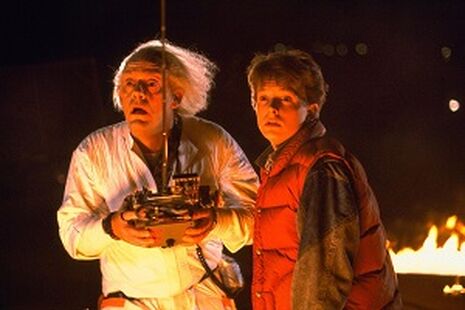Film: Back to the Future
With 2015 a big year for the franchise, Yaz Jung reminisces about this “perfect” film

Twin Pines Mall, Hill Valley, USA, Saturday, October 26th, 1985 – an aged, reclusive inventor and his young high school assistant set in motion a generational story that defines the word ‘seminal’. Back to the Future is a film Spielberg once called “the perfect movie”, as foundational to cinematic storytelling as butter-popcorn.
It is difficult to encapsulate what BTTF means to its millions of fans (both casual and devotee) around the world as it turns 30 this autumn, or what treasures it might hold for new viewers, as few films of the past 30 years have inspired such love.
The film was originally released at the height of the Reagan era, when America was pulling itself out of recession and the Cold War through gargantuan spending fuelled, in part, by a boom in consumer goods.
Back to the Future is unique in its use of familiar brands as storytelling devices in and of themselves in a seamless blend of product placement which enhances the presentation and makes the fictional world appear more ‘real’ in every time period the trilogy covers (which is the whole point of good sponsorship). For decades, fans have obsessed over branded future goods from the films such as Marty’s self-lacing Nike Mags (which finally became a reality in 2015), or the Mattel hoverboard which has inspired numerous exciting prototypes today.
Back to the Future is an existentially self-aware film. It capitalises on the 1980s’ preoccupation with the 1950s and inspired nostalgia for the 80s even before the decade was out. Marty McFly is an 80s kid. He listens to Van Halen, drinks Pepsi, skate boards to school, wears Calvin Klein, plays Nintendo and wants to buy a Toyota SUV to ride with his high-school sweetheart. When he finds himself displaced in time these same likes and desires are juxtaposed relative to the year he finds himself: a tool that helps the character and audience explore the meaning of time.
The 80s were the quintessential ‘feelgood’ decade, where a former movie star was president and a profound sense of adventure and optimism coloured much of the film, music and television of the time. BTTF combines the music of Chuck Berry, ZZ Top and Huey Lewis with a carefree reflection of how American society evolved in the years 1885 – 2015 by looking at the lives of the McFlys and their perennial competitors, the Tannens.
Back to the Future is an old fashioned film relying on actual stunts and special effects as opposed to computer graphics, and is blessed with the convergence of numerous career-making performances.
Crispin Glover as the wimpy George McFly and Thomas F. Wilson’s comic strip bully Biff Tannen provide indelible performances that will continue to resonate with audiences. Lea Thompson still looks impossibly good today and Christopher Lloyd hasn’t seemed to age at all. Michael J. Fox, chosen for his portrayal of enterprising teen go-getter Alex P. Keaton in hit sitcom Family Ties, is flawless. His physical comedy is sometimes out-and-out slapstick and renders Marty an incredibly loveable hero. Robert Zemeckis, once Spielberg’s protégé, focuses on how individual choices create temporal divergences, and treating time as a spatial phenomena uses the sequels to journey back into the first film in ingenious double cut-scenes that create a whole new form of narrating cinematic time-travel.
Above all, Back to the Future is a story of a boy who wasn’t in time for classes and wasn’t in time for dinner, until one day, he wasn’t in time at all.
 Comment / Plastic pubs: the problem with Cambridge alehouses 5 January 2026
Comment / Plastic pubs: the problem with Cambridge alehouses 5 January 2026 News / Cambridge businesses concerned infrastructure delays will hurt growth5 January 2026
News / Cambridge businesses concerned infrastructure delays will hurt growth5 January 2026 News / New movement ‘Cambridge is Chopped’ launched to fight against hate crime7 January 2026
News / New movement ‘Cambridge is Chopped’ launched to fight against hate crime7 January 2026 News / AstraZeneca sues for £32 million over faulty construction at Cambridge Campus31 December 2025
News / AstraZeneca sues for £32 million over faulty construction at Cambridge Campus31 December 2025 Interviews / You don’t need to peak at Cambridge, says Robin Harding31 December 2025
Interviews / You don’t need to peak at Cambridge, says Robin Harding31 December 2025









